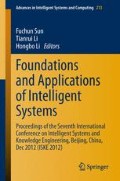Abstract
Using a multi-objective linear programming, we develop an approach to set the decision power for the multiple fuzzy rules, properly in a highly fuzziness event and earnings manipulation, whose degree of membership is difficult to observe. We use the proposed method to detect the uncovered earnings manipulators during the period 2001–2010 from the companies listed at Shanghai Stock Exchange and Shenzhen Stock Exchange. The recognition rate for in-sample test is 78.4 %, and the corresponding rate for out-of-sample test is 76.9 %.
Access this chapter
Tax calculation will be finalised at checkout
Purchases are for personal use only
References
Chou DW, Gombola M, Liu FY (2006) Earnings management and stock performance of reverse leveraged buyouts. J Fin Quant Anal 41(2):407–438
Abarbanell J, Lehavy R (2003) Can stock recommendations predict earnings management and analysts’ earnings forecast errors? J Account Res 41(1):1–31
Phillips JJ, Pincus M, Rego SO (2003) Earnings management: new evidence based on deferred tax expense. Account Rev 78(2):491–521
Zhang WD (2010) Private placement of new shares and earnings management—Empirical evidence from China’s Stock market. Manag World 1:54–63
Beneish MD (1999) The detection of earnings manipulation. Fin Anal J 55(5):24–36
Jiang JL, Li YX, Gao R (1999) Detecting earnings manipulation of listed companies based on logistic model. Econ Manage J 30:24–36
Barton J, Simko PJ (2002) The balance sheet as an earnings management constraint. Account Rev 77:1–27
Li YX, Gao R, Bao SZ, Yao H (2007) Bayes classifying analysis of earnings manipulation in listed companies in China. Forecasting 3:56–60
Yao H, Li YX, Gao R (2007) A recognition model of aggressive earnings management in Chinese listed companies based on the principal components method. J Manage Sci 20:83–91
Tsao CT (2006) A fuzzy MCDM approach for stock selection. J Oper Res Soc 57(11):1341–1352
Pietraszek J, Dwornicka R (2010) Estimation of accuracy for empirical assessment of membership function’s value. Czasopismo Techniczne Mechanika 107(8):219–228
Guo RK, Love CE (2003) Reliability Modeling with Fuzzy Covariates. Int J Reliab Qual Safety Eng 10(2):131–157
Guo RK (2005) A grey semi-statistical fuzzy modelling of an imperfectly repaired system. In: Proceedings of the 4th international conference on quality and reliability (ICQR 2005), pp 391–399 (2005)
Teoh HJ, Cheng CH, Chu HH, Chen JS (2008) Fuzzy time series model based on probabilistic approach and rough set rule induction for empirical research in stock markets. Data Knowl Eng 67:103–117
Falsafain A, Taheri SM, Mashinchi M (2008) Fuzzy estimation of parameters in statistical models. Int J Comput Math Sci 2(2):79–85
Chen JS, Chou HL, Cheng CH, Wang JY (2011) CPDA based fuzzy association rules for learning achievement mining. In: 2009 international conference on machine learning and computing, IPCSIT, vol. 3. IACSIT Press, pp 25–29
Author information
Authors and Affiliations
Corresponding author
Editor information
Editors and Affiliations
Rights and permissions
Copyright information
© 2014 Springer-Verlag Berlin Heidelberg
About this paper
Cite this paper
Li, S., Liang, H. (2014). Detection of Earnings Manipulation with Multiple Fuzzy Rules. In: Sun, F., Li, T., Li, H. (eds) Foundations and Applications of Intelligent Systems. Advances in Intelligent Systems and Computing, vol 213. Springer, Berlin, Heidelberg. https://doi.org/10.1007/978-3-642-37829-4_32
Download citation
DOI: https://doi.org/10.1007/978-3-642-37829-4_32
Published:
Publisher Name: Springer, Berlin, Heidelberg
Print ISBN: 978-3-642-37828-7
Online ISBN: 978-3-642-37829-4
eBook Packages: EngineeringEngineering (R0)

